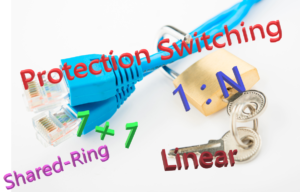What is the Tail-End within an APS (Automatic Protection Switching) System?
ITU-T G.808 Defines the Tail-End as:
The tail-end of a protection group is the end where the selector process is located. In the case where traffic is protected in both directions of transmission, the tail-end process is present at every end of the protection group.
NOTE: Whenever people discuss the tail-end of an APS system, they will sometimes use the term sink node.
ITU-T G.808 Defines the Sink Node (within a Protection Group) as:
The node at the egress of a protected domain, where a normal traffic signal may be selected from either the working transport entity or the protection transport entity.
So What Does All This Mean?
In Figure 1, we present an illustration of a Protection Group.
If we were to look closely at the Normal Traffic Signal (in Figure 1), we would see that the Tail-End is the last component that the Normal Traffic signal passes through as it exits the Protection Group.

Figure 1, Illustration of a Protection Group
The Tail-End (or Sink Node) circuitry is responsible for declaring and clearing defects and asserting (or de-asserting) the SF (Signal Fail) and SD (Signal Degrade) indicators.
The Sink Node (or Tail-End) will use these SF and SD indicators to select either the Working or Protect Transport entity as its source for the Normal Traffic Signal.
Figure 2 illustrates a simplified schematic within the Tail-End Circuitry (including the Protection-Switching Controller).

Figure 2, Illustration of the Tail-End Circuitry
Additionally, Figure 2 shows that the Tail-End Circuitry contains circuitry that detects and declares defect conditions and asserts the SF or SD indicators. This circuitry also includes the Protection-Switching Controller. I will describe how this circuitry works in another post.
Another post discusses the SF (Signal Fail) and SD (Signal Degrade) indicators.
As I show in Figure 2, the Tail-End will often use a Selector Switch that connects to the Working or Protection Transport entity.
If the Selector Switch is connected to the Working Transport entity, then the Tail-End circuitry will be using it (the Working Transport entity) as its source of the Normal Traffic signal.
The Normal Traffic signal will then propagate through the Tail-End circuitry as it exits the Protection Group.
But, if the Selector (Switch) is connected to the Protect Transport entity, then the Tail-End circuitry will be using the Protect Transport entity as its source of the Normal Traffic signal.
USING THE SELECTOR IN A 1+1 AND 1:N PROTECTION SWITCHING ARCHITECTURE
Figures 3 and 4 show drawings of the Protection Group using a Selector (Switch) in a 1+1 and 1:2 Protection Switching scheme, respectively

Figure 3, Illustration of a Selector within a 1+1 Protection Switching Scheme

Figure 4, Illustration of a Selector within a 1:2 (1:N) Protection Switching Scheme
In the case of the 1+1 Protection Switching scheme, the Working and Protect Transport entities always carry the Normal Traffic Signal.
However, the Protection Switching controller function within the Tail-End circuitry (not shown in Figure 3) will determine whether to select the Normal Traffic signal from the Working or the Protect Transport entity.
Suppose the Protection Switching controller function was to declare (for example) the SF (Signal Fail) or SD (Signal Degrade) defect condition within the Normal Traffic signal passing through the Working Transport entity. In that case, it will command the Selector Switch to switch over and connect to the Protect Transport entity.
Whenever the Selector Switch switches from the Working to the Protect Transport entities, we call this action protection switching.
Some Protection Groups support a revert feature, where the Selector Switch automatically switches back to connecting to the Working Transport entity after the SF or SD defect has cleared.
Other Protection Groups are non-reverting systems and do not support this feature.
In other blog posts, we discuss the Protection Switching controller function and the revert operation.
Clueless about OTN and Protection Switching? We Can Help!!! Click on the Banner Below to Learn More!!!
Corporate Discounts Available!!!

THE NEED FOR COMMUNICATION BETWEEN THE TAIL-END AND HEAD-END COMPONENTS OF A PROTECTION GROUP
The Selector Switch will connect to either the Working or Protect Transport entity, depending upon whether the Protection Switching controller circuitry declares the SF or SD defect within the Normal Traffic signal traveling through these transport entities.
The circuitry that detects and declares these defects (and commands the Selector to switch) resides on the Tail-End side of the Working/Protect Transport entities.
Therefore, in many Protection Switching architectures (e.g., 1:1, 1:n, and Bidirectional 1+1), the Tail-End will need to communicate and coordinate its protection-switching actions with the Head-End circuitry (within the Protection Group) via a communication link.
We discuss this APS communication link (or protocol) in another blog post.
Summary
The Tail-End (called the Sink Node) is usually the last component that a Normal Traffic Signal will pass through as it leaves the Protection Group.
The Tail-End (or Sink Node) contains circuitry that will determine if it should declare any service-affecting defects with the Working and Protect Transport entities and assert the SF (Signal Fail) signal as appropriate.
This Tail-End circuitry will also check the Working and Protect Transport entities for excessive errors (within the OTUk/ODUk signal) and assert the appropriate SD (Signal Degrade) signal.
The Sink Node (or Tail-End) circuitry will use these SF and SD signals to decide whether the Selector Switch should select the Normal Traffic Signal from the Working or the Protect Transport entities.
For normal (no defect) conditions, the Selector Switch will connect to and accept the Normal Traffic Signal from the Working Transport entity.
In this case, the Normal Traffic signal will travel from the Working Transport entity to and through the Tail-end circuitry as it leaves the Protection Group.
However, suppose the Protection-Switching controller determines that the Normal Traffic signal, when passing through the Working Transport entity, contains service-affecting defects, such as SF or SD. In that case, it will command the Selector Switch to switch over and connect to the Protect Transport entity.
In this case, the Selector will now obtain the Normal Traffic signal from the Protect Transport entity (instead of the Working Transport entity).
Whenever the Selector switches from the Working to the Protect Transport entity, we call this action Protection Switching.
Has Inflation got You Down? Our Price Discounts Can Help You Beat Inflation and Become an Expert on OTN and Protection-Switching!! Click on the Banner Below to Learn More!!
Discounts Available for a Short Time!!!

Click on the Image Below to see more Protection-Switching related content on this Blog:

Protection-Switching Related Blog Posts Basic Protection-Switching Terms Head-End (Source Node) Hold-Off Timer Protection-Group Protection-Transport entity Selector Switch Tail-End (Sink Node) ...











